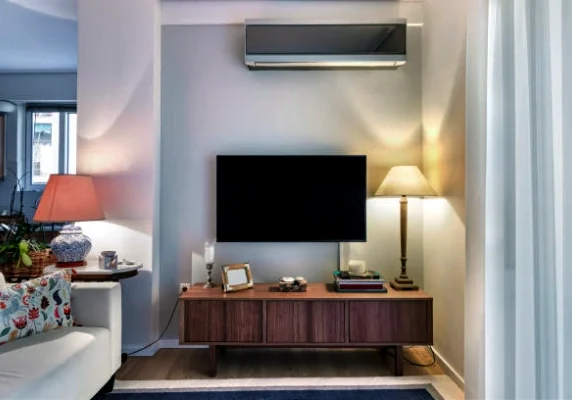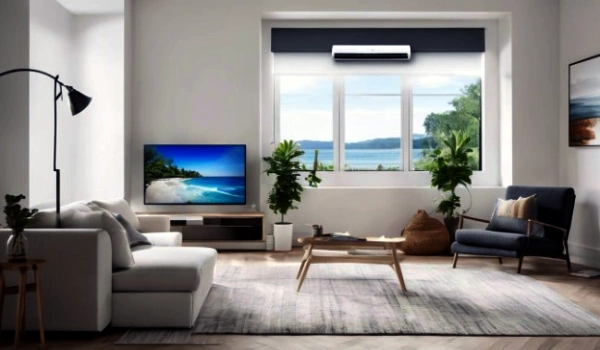Do Mini Splits Use a Lot of Electricity?

Imagine being able to control the temperature of each room in your house separately, all while saving money on your energy bills. It sounds dreamy, right? This is where mini-split systems come into play. However, one lingering question often halts homeowners: “Do mini splits use a lot of electricity?”
In this post, we dissect the energy consumption and cost analysis of mini-split systems so you can make an informed decision about your home’s heating and cooling solutions.
Understanding Mini Split Systems and Their Functioning
Before diving into the details of energy consumption, it’s crucial to have a solid understanding of how mini split systems function. Unlike traditional central air conditioning units, mini splits consist of two main components: an outdoor condenser unit and one or more indoor air handlers. These components are connected by a conduit that houses refrigerant lines, power cables, and a condensate drain. The outdoor unit extracts heat from the outside air and transfers it to the indoor units for cooling or heating purposes.
Mini splits offer several advantages over traditional HVAC systems. They are highly efficient because they use inverter technology, which allows them to adjust their speed based on cooling or heating demand. This adaptive functionality eliminates the energy waste associated with frequently turning on and off as conventional units do. Additionally, mini splits allow for zone-based temperature control, enabling you to cool or heat specific areas of your home rather than the entire space.
Evaluating Energy Consumption: How Much Electricity Do Mini Splits Use?
One common concern among homeowners considering mini split systems is their energy consumption and potential impact on utility bills. Fortunately, mini splits boast impressive energy efficiency ratings due to various factors:
- Inverter Technology: As mentioned earlier, mini splits employ inverter technology, which enables them to operate at variable speeds. By adjusting their energy output based on actual needs, they consume less electricity compared to traditional AC units that continuously cycle on and off at fixed capacities.
- No Ductwork Loss: Conventional central air conditioning systems often suffer from ductwork losses as cooled or heated air passes through long ducts before reaching the desired areas. In contrast, ductless mini split systems eliminate this concern by delivering conditioned air directly into each zone without the need for ducts, reducing energy waste.
- Zoning Capabilities: Mini splits provide the flexibility to cool or heat specific zones, allowing you to avoid wasting energy on unoccupied areas. By independently controlling each indoor air handler, you can customize temperature settings according to usage patterns and occupant preferences.
- Energy Star Ratings: Another significant advantage of mini splits is that many models are Energy Star rated. This certification ensures that the systems meet rigorous efficiency standards set by the U.S. Environmental Protection Agency, providing consumers with reliable information about their energy consumption.
Remember, while mini splits are energy-efficient, several factors can influence their overall electricity usage, such as climate conditions, insulation levels, set temperatures, and system sizing. It’s essential to consult with a professional HVAC technician who can assess your specific needs and recommend an appropriately sized system for optimum efficiency.
Comparative Analysis: Traditional AC Units vs Mini Splits
When it comes to cooling your home or office, understanding the energy consumption and cost implications of different air conditioning systems is crucial. One key comparison that can be made is between traditional AC units and mini splits.
Traditional AC units, also known as central air conditioners, rely on a duct network to distribute cool air throughout the building. This system requires extensive ductwork installation, which can lead to energy loss through leaks and inadequate insulation. Additionally, traditional AC units often operate using a single thermostat for the entire space, leading to inefficiencies in temperature control and energy usage.
On the other hand, mini splits, also known as ductless mini-split systems, provide targeted cooling without relying on ducts. These systems consist of an outdoor unit connected to one or more indoor units through refrigerant lines. The lack of ductwork eliminates potential energy losses due to leaks or insufficient insulation.
For instance, imagine a scenario where a traditional AC unit is cooling an entire house. Some rooms may be unoccupied or used less frequently than others. In this case, the central AC system would continue to cool those rooms along with the occupied spaces. This results in unnecessary energy consumption. In contrast, with a mini split system, you have precise control over each indoor unit’s cooling operation, allowing you to save energy by only cooling occupied areas. Learn more about the differences between traditional AC units and ductless mini splits.
Influential Factors: What Affects Mini Split Energy Consumption?
While mini splits are generally known for their energy efficiency advantages compared to traditional AC units, several factors can influence their energy consumption.
One significant factor is the size and capacity of the mini split system itself. Choosing the right-sized system for your space ensures optimal performance and efficiency. An oversized system will cycle on and off too frequently, wasting energy in the process. Conversely, an undersized system may struggle to cool your space adequately and need to work harder, consuming more energy.
Insulation and air sealing of the building also play a vital role in energy efficiency. Poor insulation or air leaks can allow cool air to escape, causing the mini split system to work harder to maintain the desired temperature. Investing in proper insulation and addressing any gaps or cracks can help reduce energy consumption.
The local climate is another influential factor. Mini splits are more efficient in moderate climates where extreme heat or cold is not a constant issue. In areas with high humidity levels, mini splits with dehumidification features can provide additional energy-saving benefits.
Lastly, individual habits and usage patterns affect energy consumption. Setting appropriate thermostat temperatures and using programmable thermostats can help optimize energy usage. Additionally, practicing energy-conscious behaviors like closing doors and windows when running the system, using ceiling fans to supplement cooling, and utilizing natural shading can further enhance efficiency.

The Role of Thermostat Settings and Compressor Efficiency
When it comes to the energy consumption of mini split systems, two crucial factors play a significant role: thermostat settings and compressor efficiency. The thermostat setting determines the desired temperature, while the compressor is responsible for achieving and maintaining that temperature efficiently.
Thermostat settings greatly impact the electricity usage of a mini split system. By setting the thermostat temperature higher in the summer or lower in the winter, you can reduce overall energy consumption. For example, raising the set temperature by just a few degrees during cooling seasons can significantly decrease energy usage and result in cost savings. It’s important to find a comfortable yet efficient balance that suits your preferences.
Let’s say you typically keep your mini split system running at 70°F during the summer months. By increasing the thermostat setting to 75°F, you’ll be able to reduce energy consumption without sacrificing too much comfort. This adjustment can make a noticeable difference in your electricity usage and ultimately lower your utility bills.
In addition to thermostat settings, compressor efficiency is another critical factor affecting energy consumption. An efficient compressor can cool or heat a space using less power, resulting in lower electricity usage and operating costs. Choosing an energy-efficient mini split system with a high Seasonal Energy Efficiency Ratio (SEER) or Heating Seasonal Performance Factor (HSPF) rating can help maximize efficiency and save on energy costs over time.
A Practical Look: Estimating Mini Split Operational Costs
Estimating the operational costs of a mini split system involves considering various factors such as the unit’s capacity, hours of operation, local electricity rates, and seasonal changes. While it may seem complex initially, breaking it down into smaller steps can provide clarity and help you make informed decisions.
To estimate the operational costs, start by determining the capacity or size of your mini split system. This information can typically be found on the unit or in its documentation. Once you have the capacity in British Thermal Units (BTUs), you can calculate the energy consumption based on the BTU rating and the hours of operation per day.
Next, consider your local electricity rates, which may vary depending on your location. You can find this information on your utility bills or by contacting your electricity provider. Multiply the energy consumption (in kilowatt-hours) by the electricity rate to estimate the daily cost of operating your mini split system.
Lastly, keep in mind that seasonal changes can affect operational costs. During extremely hot or cold periods, the mini split system may need to work harder to reach and maintain the desired temperature, resulting in increased energy usage.
For example, let’s say you have a 12,000 BTU mini split system with an average daily usage of 10 hours. If your local electricity rate is $0.12 per kilowatt-hour, you can calculate that your daily operating cost would be approximately $1.44 (12 kWh x $0.12/kWh). Multiplying this by the number of days in a month will give you an estimate of monthly operational costs.
By following these steps and considering factors such as capacity, hours of operation, electricity rates, and seasonal variations, you can gain a practical understanding of how to estimate the operational costs associated with running a mini split system. Learn more reasons to invest in a ductless mini split system!
Final Words
Understanding the electricity consumption of ductless mini split AC units is crucial for homeowners seeking efficient cooling solutions. At Diamond Comfort, we value transparency and strive to equip you with all of the information necessary for informed decisions. If you’re considering installing one of these energy-efficient systems, our experts are on hand to guide you – offering tailored energy-saving solutions that ensure optimal comfort while minimizing electricity usage. Ready to upgrade to more energy-efficient cooling? Get in touch with Diamond Comfort now for professional installation and personalized recommendations!
Have Any Questions?
Get in contact with us today! We are always happy to help, and you can count on our expertise.

